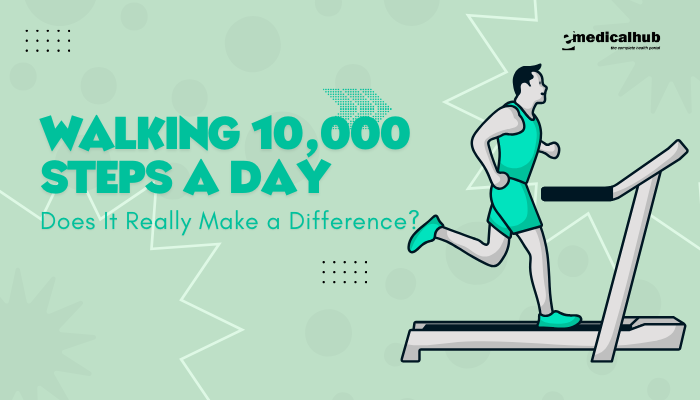Introduction
For years, many fitness trackers, health apps, and articles have touted “10,000 steps a day” as a crucial milestone for better health and weight management. It’s such a familiar number that many people assume it must be the science-backed magic bullet for daily physical activity.
But is 10,000 steps truly a “magic” threshold, or just an arbitrary figure popularized by marketing and tradition? Can aiming for this step count really improve your health – or are you just racking up numbers on your watch?
In this article, we’ll explore the origins of the 10,000-step guideline, examine the actual health benefits linked to daily step counts, and discuss how to adapt step goals to personal fitness levels and goals.
Whether you already have a pedometer or wearable, or are thinking of picking one up to start counting steps, understanding what the data really signifies can help make your walking routines more meaningful and effective.
Disclaimer: This information is for general educational purposes only. Always consult a healthcare professional before making significant changes to your exercise routine, particularly if you have underlying health conditions or concerns.
The Origin of the 10,000 Steps Concept
A Marketing Start
Surprisingly, the 10,000-step target has less formal scientific basis than many might expect. The concept is thought to have originated in Japan in the 1960s with a pedometer product called “Manpo-kei,” which translates to “10,000 steps meter.” Manufacturers used the figure largely for promotional purposes. Over time, health organizations picked it up, and the number stuck—likely because it’s easy to remember and a round, motivational goal.
Quick Uptake by Health Guidelines
Despite its somewhat arbitrary roots, health authorities worldwide have referenced 10,000 steps as a general daily activity target. It’s a convenient reminder to stay active, bridging sedentary lifestyles with moderate exercise. However, guidelines like the Physical Activity Guidelines for Americans typically measure activity in minutes (e.g., 150–300 minutes of moderate exercise weekly), not necessarily steps, acknowledging that different intensities and body types might need different targets.
Health Benefits of Achieving Higher Step Counts
Cardiovascular Health
Walking is an accessible form of exercise that:
- Improves Cardiorespiratory Fitness: Regular walking helps your heart pump more efficiently, can lower blood pressure, and support healthier cholesterol levels.
- Lowers Cardiac Risk: Multiple studies correlate higher step counts with reduced incidence of coronary artery disease and stroke risk factors.
Weight Management and Metabolic Benefits
Reaching 10,000 steps (about 4.5–5 miles for an average stride) can help create a modest calorie burn to complement dietary management. Additional benefits:
- Enhanced Insulin Sensitivity: More movement throughout the day can regulate blood glucose.
- Potentially Higher NEAT: Non-exercise activity thermogenesis (NEAT) can significantly contribute to daily calorie expenditure, especially if steps are spread through the day.
Bone and Joint Advantages
Walking is a weight-bearing activity that can:
- Strengthen Bones: Repetitive impact and muscle usage help maintain bone density.
- Support Joint Mobility: Regular walking can reduce stiffness in knees and hips, aiding those with mild arthritic issues, provided the impact is not too high for existing conditions.
Mental Well-being
Even moderate daily walking can:
- Reduce Stress: Gentle movement releases endorphins and can calm the mind.
- Improve Mood and Cognition: Some research points to better memory, reduced anxiety, and overall mental health improvements linked to consistent physical activity.
Is 10,000 Steps a Magic Number?
Dose-Response Relationship
Most research indicates a dose-response for activity: more steps generally equate to better health outcomes, but you don’t need to jump straight to 10,000 to see benefits. Some studies show:
- 5,000–8,000 steps daily can meaningfully reduce risks for chronic diseases.
- 7,000–9,000 steps might further cut mortality risk for middle-aged and older adults.
Hence, if you’re currently doing 3,000 steps a day, increasing to 6,000 might yield big improvements, even if you don’t yet hit 10,000.
Individual Variations
Body type, age, and goals influence how many steps you might aim for:
- Sedentary Beginners: Starting at 6,000 daily steps might be more realistic, building gradually.
- Active Individuals: Runners or physically active people might exceed 10,000 easily, possibly reaching 15,000.
- Occupational Context: A nurse or waiter might surpass 10,000 at work alone, while an office worker might get fewer steps unless they incorporate breaks or lunchtime walks.
So while 10,000 is a decent guideline, the best step goal is one that challenges but remains achievable given personal circumstances.
The Role of Intensity
Not all steps are created equal. A brisk walk or uphill steps can be more beneficial than slow, meandering steps. For robust cardiovascular benefits, health experts often suggest mixing moderate to vigorous walking, or additional routines like hills, intervals, or speed bursts.
Tracking and Motivating Yourself
Using Wearables or Smartphone Apps
Most smartphones, pedometers, or wearable fitness trackers can reliably capture step counts with decent accuracy (±10–15%). For consistent usage:
- Place the Device consistently (wrist or pocket) daily.
- Review Patterns: Are steps mostly done in short bursts or throughout the day?
- Track Trends: Aim for weekly or monthly improvements, not daily perfection.
Setting Incremental Goals
- Incremental Approach: If you average 4,000 steps, push for 4,500 or 5,000, then move upward.
- Add “Movement Snacks”: Taking 2–5 minute walking breaks each hour can be an easy method to accumulate steps.
- Reward Systems: Some apps or group challenges reward consistency, not just raw counts.
Integrating Steps Into Routine
- Walk During Calls: Pace around your home or office on phone calls.
- Park Farther Away: Increase daily activity in small increments.
- Take the Stairs: Each flight adds steps and boosts intensity.
Potential Pitfalls and Limitations
Overemphasis on Step Count Only
Fixation on daily steps may overshadow other crucial aspects of fitness:
- Strength and Flexibility: Steps alone might not preserve muscle mass or mobility as well as resistance exercises or stretching.
- Cardio Intensity: 10,000 easy steps might not elevate heart rate sufficiently to build aerobic capacity. Complement with moderate/vigorous sessions for synergy.
- Variety: The body thrives on multiple movement patterns. Solely relying on step count can lead to repetitive strain or plateau.
Device Inaccuracies
Though generally good, trackers can miscount if:
- Arm movements are mistaken for steps (like brushing your hair).
- Walking with pushcarts or hands in pockets might lead to undercounting.
- Battery and daily calibration can shift accuracy slightly.
Rely on step data as approximate trends, not absolute precision.
Risk of Overuse Injuries
A sudden jump from 2,000 to 10,000 steps daily can stress ankles, knees, or hips, especially if you have joint vulnerabilities. Gradual progression is wise, focusing on comfortable footwear and balanced foot mechanics.
Adapting the “10,000 Steps” for Different Groups
Older Adults or Low Mobility
For seniors or those with mobility challenges:
- Set a Realistic Target: Maybe 3,000 or 5,000 steps, combined with balance or flexibility exercises.
- Short Walks: 2–3 short walks daily can accumulate into a beneficial total, reducing fall risk and supporting cardio health.
Busy Professionals
- Mini-Bursts: 5-minute active breaks every hour can add up to a respectable total.
- Lunchtime Walk: 15–20 minutes can yield 1,500–2,000 steps, chunking the day’s total effectively.
- Commuter Options: If safe, consider walking part of the journey or stepping off transit a stop early.
Athletes or Fit Individuals
Already training vigorously? Steps might seem trivial, but:
- Active Recovery: An easy day with 10,000 steps can be a gentle means to maintain movement while letting the body recover.
- Supplement to Sedentary Work: If your job is desk-based, ensuring a minimum step count ensures baseline daily activity beyond intense training sessions.
Combining Steps with Other Exercises
Strength Training for Overall Fitness
A well-rounded regimen includes:
- Resistance Work: 2–3 times/week, focusing on major muscle groups.
- Walking: As daily low-impact cardio. Steps become a baseline for daily movement while strength sessions handle muscle and bone density.
Interval Walking
Power walking intervals or short speed bursts can add intense stimuli to walking:
- E.g., 2 minutes brisk, 1 minute moderate, repeat 5 times.
- This can raise HR, combine aerobic benefits with the simplicity of walking.
Cross-Training
Besides walking, incorporate:
- Cycling, Swimming, Yoga: Variety helps reduce repetitive strain, fosters better overall fitness.
- HIIT: For those seeking advanced cardio/strength. The step count from short sprints or plyometrics might or might not fully register, but the conditioning benefits remain.
Frequently Asked Questions (FAQ)
- How many steps equal one mile?
Typically ~2,000 steps equal about 1 mile for an average stride. This can vary based on height, stride length, and walking speed, ranging roughly 1,900–2,400 steps/mile. - Is 10,000 steps enough to lose weight?
Weight loss depends on total calorie balance. 10,000 steps can help burn extra calories (200–400 for many), but diet quality and portion control remain crucial. Over time, combining more movement with healthy eating fosters gradual weight loss. - Are short high-intensity workouts better than 10,000 steps?
Both have unique benefits. High-intensity workouts yield potent cardio improvements in less time, whereas daily step goals keep you consistently active. Some prefer a hybrid approach to address both base activity and fitness peaks. - Do steps from cleaning or chores count?
Yes, any walking-based movement typically registers. Housework or errands can significantly boost daily totals, showcasing the advantage of measuring overall daily movement. - Can I break up the step goal?
Absolutely. Multiple short walks or “activity snacks” can accumulate to 10,000 steps, and might be easier on joints than one long session.
Conclusion
The popular 10,000 steps a day target is not a strict science-derived figure, but it’s proven to be a convenient benchmark for encouraging more movement, especially in an era where many fall short of recommended physical activity. Consistent walking at moderate intensity confers a host of benefits—better cardiovascular health, potential weight management, bone strength, and mental well-being. For most moderately healthy adults, striving for around 10,000 steps ensures a degree of daily movement that aligns with general health guidelines, though the best step count can vary individually.
Whether you’re beginning from a low-activity baseline or you’re already an avid exerciser, focusing on your step count can reveal insights into your daily movement patterns and act as a motivational tool. Just remember that steps are only part of the picture—mixing in strength training or more vigorous activity can compound results. Ultimately, meeting or exceeding 10,000 steps is beneficial, but not mandatory for every person. Listen to your body, consider your baseline, and use step tracking as one dimension of a balanced, active lifestyle. Increasing daily walking from wherever you are now, in safe increments, is the real key to progressive, sustainable health gains.
References
- Tudor-Locke C, Craig CL, Aoyagi Y, et al. How many steps/day are enough? Sports Med. 2011;41(1):567–600.
- Lee IM, Shiroma EJ, Kamada M, et al. Association of step volume and intensity with all-cause mortality in older women. JAMA Intern Med. 2019;179(8):1105-1112.
- Paluch AE, et al. Steps for health. Circulation. 2021;143(18):1792–1795.
- C3 Collaborating for Health. The benefits of regular walking for health, well-being, and the environment. 2012.
- Hackney KJ, et al. The effects of walking on metabolic health. Curr Sports Med Rep. 2019;18(8):307-315.
- Shrestha N, et al. Office-based physical activity interventions on health. J Occup Health. 2018;60(4):281-293.
- Thompson PD, et al. Exercise and physical activity in the prevention and treatment of atherosclerotic cardiovascular disease. Circulation. 2003;107(24):3109-3116.
- US Department of Health and Human Services. Physical Activity Guidelines for Americans, 2nd edition. 2018.
- Tudor-Locke C, et al. Step-based Physical Activity Metrics. J Behav Med. 2016;39(2):279-282.
- Keadle SK, et al. Reproducibility of device-based stepped measures. Med Sci Sports Exerc. 2020;52(4):897-907.
- Haskell WL, et al. Physical activity guidelines and daily step targets. Exerc Sport Sci Rev. 2017;45(1):24-32.
- CDC. The Benefits of Physical Activity. Updated 2021.






